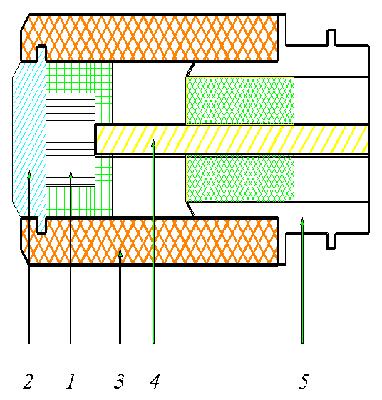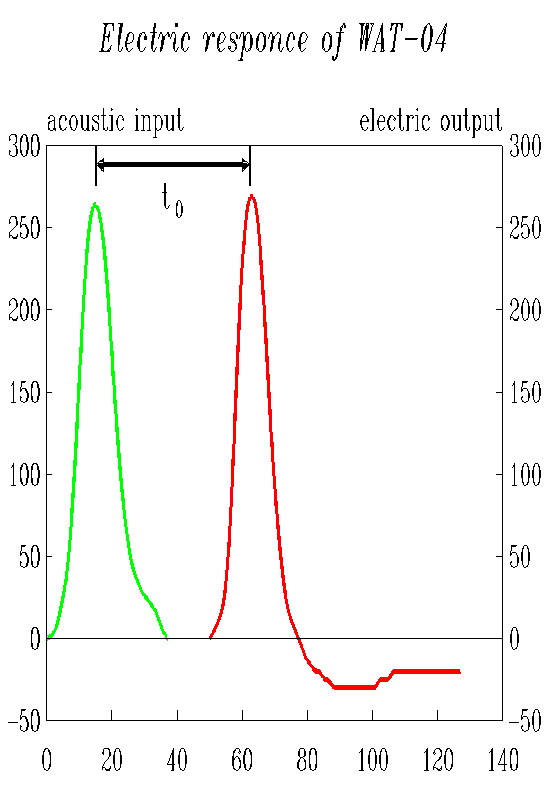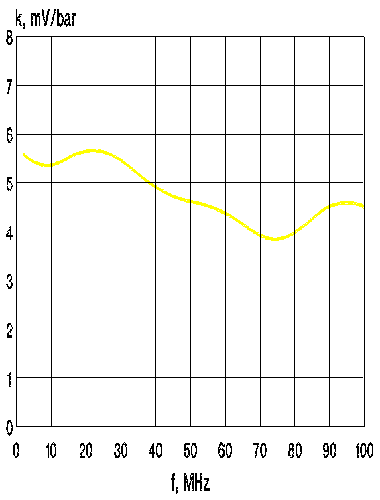WIDEBAND ACOUSTIC TRANSDUCER (WAT)
WAT is a wideband piezoelectric receiving transducer, which is adapted for registering of acoustic pulses of nanosecond duration in liquids and solids. It can be used for investigation and evaluation of laser action on condensed matter, for wideband acoustic spectroscopy, acoustic microscopy and nondestructive testing. 
fig. 1 The sensitive element of WAT (see fig.1) is LiNbO crystal 1 (it's diameter d =6 mm), connected with acoustic conductor 2 (diameter of receiving aperture d =8 mm). They are mounted into metal one-piece casing 3, which is "ground" electrode. An electrical signal is formed at contact 4 (it's diameter is 3 mm) at back surface of piezoelement. This signal is fed into external circuit by BNC-connector 5. According to WAT type the piezoelement is used in open-circuit regime (R >10 kW ), or in short-circuit regime (R =50 W ). In the first case the output signal is fed directly to a fed-probe (or charge amplifier) and the length of connecting cable has to be less then 20 cm. In the second case the connecting cable has a characteristic wave impedance R =50 W and has to be loaded by R =50 W at a free tail. 
fig. 2 WAT-04 type unit. works in a short-circuit regime. The time delay between the acoustic signal on acoustic conductor face and an electric signal at WAT output is t0 (for WAT-04 type t0 =1.54m s, see fig.2). Reverberation signal may appear after time delay t = 1.0 m s, which limits the duration of correctly registered acoustic pulses. The high frequency limit fm is determined by attenuation of acoustic wave in the acoustic conductor, piezoelement and bond layer. The calibration of WAT is carried out in a frequency range up to 70-100 MHz. Each WAT is calibrated especially. The sensitivity of WAT k(f) is determined relatively to the amplitude of acoustic wave, propagating in the acoustic conductor. Amplitude of acoustic wave in the acoustic conductor pc and in immersion substance pi are connected as follows:
where U is electric voltage, Zc and Zi -acoustic impedances of the acoustic conductor and the immersion substance respectively. For WAT-04 Zc = 1.26*106 g/s cm2. 
Fig.3 The frequency dependence of sensitivity of WAT-04 #26 is shown in fig.3. The sensitivity of WAT remains practically constant at least up to the amplitudes of pressure 10 MPa. The noise level corresponds to output voltage 50-120 m V (in a frequency range over 100 MHz). Practically, however, it is determined by the level of electrical noise disturbance. Dynamic range of measurements is 20-30 dB. WAT-04 can be mounted in a chamber, using the metal one-piece casing, which diameter D=14.0 mm. WAT-04 #26 CHARACTERISTICS Sensing element: LiNbO3; diameter 6 mm; thickness 6 mm; Acoustic conductor: SiO2 (fused); aperture 8 mm; thickness 5 mm; impedunce 1.26*106 g/cm2s; Transducer: acoustic pulse duration 7 ns - 0.9 m s; time delay t0 between acoustic input and acoustic pressure range 1 kPa - 10 MPa; dynamic range 22 dB; electric loading 50 W ; cable length < 1.5 m; diameter of casing 14 mm.
|
 ,
,